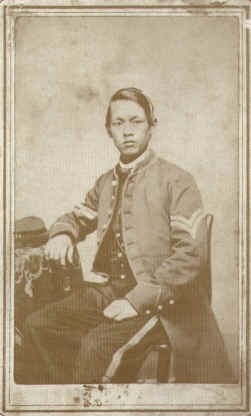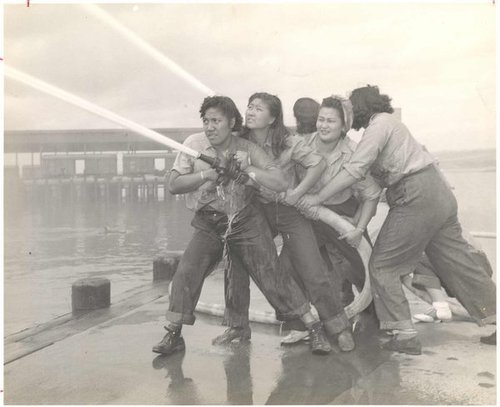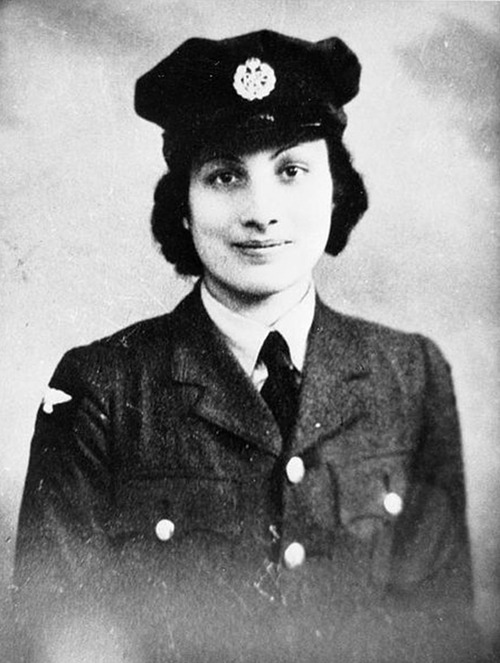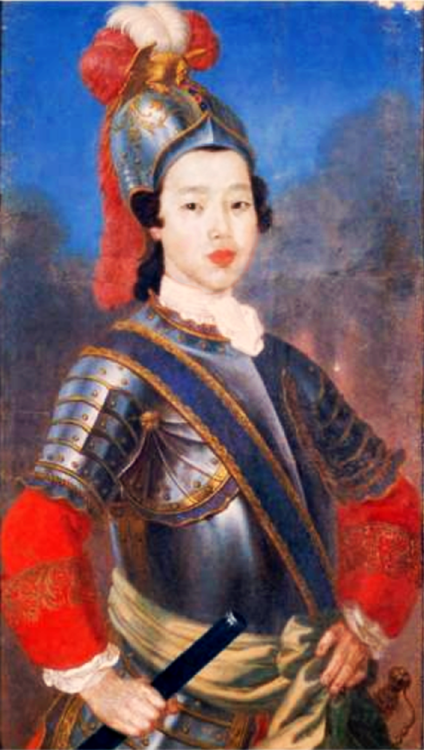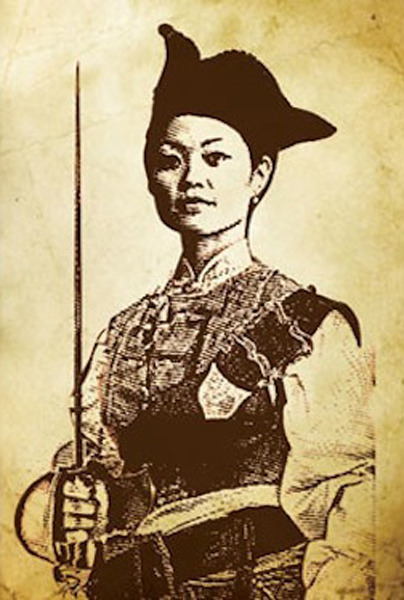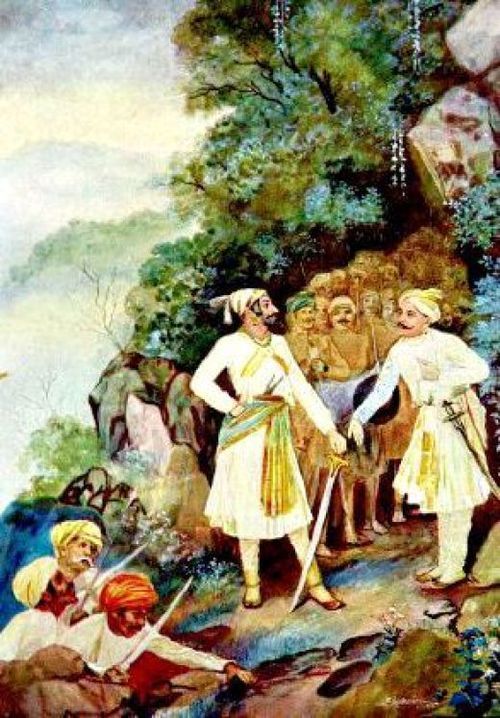Mad Jack Churchill
Every few months on the web, a new candidate emerges for the Bad-Ass Hall of Fame, a collection of amazing people who lived large, walked their own path, and left their mark on history with flair. Today’s candidate is Mad Jack Churchill, a British Commando leader during World War II who died in 1996. Churchill fought in the war armed with a bow & arrows, a broadsword, and occasionally even bagpipes. Here’s a photo of him (far right) during a training exercise in Scotland, sword in hand as he storms the beach:
What a sight he must have been, leading charges branishing a sword and sucking on his pipes. Churchill even killed a German soldier in France with an arrow, recording the only known kill by bow in the war for the British. From a profile in WWII History magazine:
During the BEF’s fighting retreat, Churchill remained aggressive, unwilling to give up a yard of ground while extracting the maximum cost from the enemy. He was especially fond of raids and counterattacks, leading small groups of picked soldiers against the advancing Germans. He presented a strange, almost medieval figure at the head of his men, carrying not only his war bow and arrows, but his sword as well.
As befitted his love of things Scottish, Churchill carried the basket-hilted claymore (technically a claybeg, the true claymore being an enormous two-handed sword). Later on, asked by a general who awarded him a decoration why he carried a sword in action, Churchill is said to have answered: “In my opinion, sir, any officer who goes into action without his sword is improperly dressed.”
The war-diary of 4th Infantry Brigade, to which Churchill’s battalion belonged, commented on this extraordinary figure. “One of the most reassuring sights of the embarkation [from Dunkirk] was the sight of Captain Churchill passing down the beach with his bows and arrows. His high example and his great work … were a great help to the 4th Infantry Brigade.”
And this bit sounds totally made up:
Churchill himself was far in front of his troopers. Sword in hand, accompanied only by a corporal named Ruffell, he advanced into the town itself. Undiscovered by the enemy, he and Ruffell heard German soldiers digging in all around them in the gloom. The glow of a cigarette in the darkness told them the location of a German sentry post. What followed, even Churchill later admitted, was “a bit Errol Flynn-ish.”
The first German sentry post, manned by two men, was taken in silence. Churchill, his sword blade gleaming in the night, appeared like a demon from the darkness, ordered “haende hoch!” and got results. He gave one German prisoner to Ruffell, then slipped his revolver lanyard around the second sentry’s neck and led him off to make the rounds of the other guards. Each post, lulled into a sense of security by the voice of their captive comrade, surrendered to this fearsome apparition with the ferocious mustache and the naked sword.
Altogether, Churchill and Corporal Ruffell collected 42 prisoners, complete with their personal weapons and a mortar they were manning in the village. Churchill and his claymore took the surrender of ten men in a bunch around the mortar. He and his NCO then marched the whole lot back into the British lines.
As Churchill himself described the event, it all sounded rather routine: “I always bring my prisoners back with their weapons; it weighs them down. I just took their rifle bolts out and put them in a sack, which one of the prisoners carried. [They] also carried the mortar and all the bombs they could carry and also pulled a farm cart with five wounded in it….I maintain that, as long as you tell a German loudly and clearly what to do, if you are senior to him he will cry ‘jawohl’ and get on with it enthusiastically and efficiently whatever the … situation. That’s why they make such marvelous soldiers…”
Crazy! After the war, he took up boat refurbishing, river surfing, and freaking out train passengers:
In his last job he would sometimes stand up on a train journey from London to his home, open the window and hurl out his briefcase, then calmly resume his seat. Fellow passengers looked on aghast, unaware that he had flung the briefcase into his own back garden.
Rest in peace, Mad Jack. (via today i found out)
Five Historical Movies About Asians Hollywood Never Made
1. Asian Soldiers in the American Civil War
Edward Day Cahota and Corporal Joseph L. Pierce were two of a known total of 58 Asian soldiers who fought in the American Civil War. Pierce was the highest ranked Chinese-American to have served in the war and was at both the Battle of Gettysburg and Antietam ( x ). Cahota was found, half-starving on a ship when he was a child, before being adopted by the captain and growing up as a cabin boy. In 1864, he served under General Ulysses S. Grant.
Both Pierce and Cahota were denied citizenship, due to the 1882 Chinese Exclusion Act, even despite the fact that Cahota had served for 30 years with the army. Cahota, however, “was said to have enjoyed telling his children that he had voted repeatedly—in fact, had cast his ballots for Republicans for 30 years—before it was found out that he was not really a citizen and therefore not qualified to vote.” ( x )
Did we mention that Joseph L. Pierce looked great in uniform?
2. Asian Women in WWII
As soon as the war began, Asian-American women entered the workforce along with their white neighbors. The Chinese Women’s Association raised over $30,000 in donations for war refugees, and women from all over the country contributed their skills and time to the war effort. Katherine Lowe, who was of Hawaiian and Chinese descent and her best friend Elizabeth Moku both applied for jobs at the Pearl Harbor Naval Shipyard. There they lugged around oil drums, trained to fight fires, and Moku played with an undefeated baseball team. ( x )
Across the Atlantic, British Asian Noor Inaya Khan served as a radio operator of a French resistance network, under the codename ‘Madeleine.’ She doggedly avoided capture as other members of the network were arrested, moving quickly and never staying in one place for very long. Betrayed by a Frenchwoman, Khan was finally found by the Gestapo, escaped from prison, only to be captured again soon after. She remained staunchly loyal, even under torture, and gave her life to the cause when she was sent to the Dachau concentration camp and executed. ( x )
Rosie the Riveter has always looked liked us. The question is when will Hollywood catch up with history.
3. Siguhara Chiune
The other WWII hero Spielberg could (and should) have made a movie about, Siguhara Chiune saved the lives of over 6,000 Jews by issuing them travel visas to Japan. Serving as Vice-Consul for Japan in Lithuania at the time, Sughara ignored the sky-high requirements the refugees couldn’t meet, and after consulting with his family, began writing visas in direct violation of his orders. And yet, not only did he issue visas illegally, he issued a months worth of them each day, spending 18-20 hours a day on his mission.
And there’s more:
On the night before their scheduled departure, Sugihara and his wife stayed awake writing out visa approvals. According to witnesses, he was still writing visas while in transit from his hotel and after boarding the train at the Kaunas Railway Station, throwing visas into the crowd of desperate refugees out of the train’s window even as the train pulled out.
In final desperation, blank sheets of paper with only the consulate seal and his signature (that could be later written over into a visa) were hurriedly prepared and flung out from the train. As he prepared to depart, he said, “Please forgive me. I cannot write anymore. I wish you the best.” When he bowed deeply to the people before him, someone exclaimed, “Sugihara. We’ll never forget you. I’ll surely see you again!” ( x )
If that’s not Oscar bait, we don’t know what is.
4. Xiang Fe the Fragrant Concubine
Allow us to quote directly from Medieval POC, one of our favorite blogs on tumblr.
The Fragrant Concubine is a figure who blends history with legend in a way that has yet to be unraveled. She is said to have been an Uighur. The Uighurs are a Muslim Ethnic group concentrated in the Northwestern Chinese Province of Xinjiang […] According to legend, after the glorious defeat of the Uighurs in Altishahr in 1759, the triumphant Manchu general Zhahui returned to Beijing with war booty, including the remarkable consort […] said to emit a natural fragrance and became known as the Fragrant Concubine.
Although given to the Quinlong Emperor as a concubine, she resisted any intimate contact with him and carried small knives in the sleeves of her clothing in order to revenge the loss of her homeland. But he emperor was so entrances with her that he is said to have built a Muslim mosque and bazaar just beyond the southwest corner of the Beijing Palace…and a tower just inside the walls from which she could supposedly ease her homesickness by watching her fellow Muslims conducting business and going to the mosque.
So many cosplay possibilities, so little time.
5. Pirates!
Wipe the unfortunate caricatures from Pirates of the Caribbean 3 out of your mind. Ching Shih not only gave the colonial powers a run for their money, she was one of the few pirates to live long and well enough to retire, let alone do so with an undefeated track record of terror. A prostitute kidnapped by pirates, she married their captain and maneuvered her way into power after his death by building rapport with her rivals. She united the fleet of pirates her husband began under a new moral code of law, which included a death sentence for any pirate who raped a female captive. ( x )
The Pirates of the Malabar had their fair share of adventure as well. Lead by Kanhoji Angre, the Maratha Confederacy attacked merchant ships of the East India Trading Company, and in 1712, Angre captured the British President of Mumbai. In 1715, the new British President of Mumbai tried to return the favor, only have three of his ships taken and his port blockaded. Angre ransomed 8,750 pounds from the East India Company for his troubles. Considered a hero by anti-imperialists, a statue of Angre stands in the Naval Dockyard in Mumbai. ( x )
Hollywood, we are waiting.



















